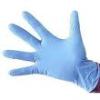
Manufacturing a protective boot that can meet exacting national standards is challenging enough. When the relevant industry adds its own performance testing to the mix, as the aluminum smelter industry around the world has done, the challenge grows — but this happens for all the right reasons.

Throwing sharps containers, red bags, and spill cleanup materials into the trash sends up a red flag to commercial or municipal trash collectors because they are not allowed to take this waste.

The Health and Safety Executive revised its training regime on Oct. 1, 2009, to give employers more flexibility in how they train workers to provide first aid during emergencies. It says someone should be appointed to look after first aid supplies, including medical gloves.
In addition to the combustible dust violations, an inspection found that the Delaware company failed to provide fire retardant clothing for employees and require them to wear adequate eye protection with side shields, among other hazards.
CE (EU) glove standards are mandatory in Europe and most gloves sold in North America are imported, so you will see this symbol more often.

What is the big deal about constructing, operating, and servicing a wind turbine? Ask anyone who has been involved in this industry for more than 20 years, and he will describe a time that is different from today only in the breadth and scale of these renewable energy-generating machines.
The company, which manufactures guyed and self-supporting towers and monopoles, was charged with three willful and 38 serious violations.

A March 19 memo sent to regional administrators and state plans by Richard Fairfax and Steve Witt, who head the OSHA enforcement and state programs units, clarifies when citations should be issued for failing to provide it.
OSHA advises flood recovery workers to evaluate work areas for all hazards and use personal protective equipment.

The country's Ministry of Manpower promised on Monday to focus enforcement inspections on construction and maritime, where 63 percent of the 2009 fatalities occurred.
According to FMCSA, safety belt use was at 78 percent in states with primary safety belt laws, which allow law enforcement to stop drivers for not using a safety belt, versus 67 percent in states with weaker laws.
The company was inspected as part of a federal site-specific targeting program based on its high injury and illness rates in comparison to the national rates.

Several agencies within the department, including OSHA, have their own presentations on the DOL page that explain how they support the draft plan. It will be posted for review and comment in July.
Appropriate personal protective equipment such as safety goggles and gloves must be worn to protect against hazards that may be encountered while using hand tools. Workplace floors shall be kept as clean and dry as possible to prevent accidental slips with or around dangerous hand tools.
The eTool provides preventative tips for protecting electric power workers’ safety and health.
The 45 serious violations of which the facility stands accused address hazards with industrial trucks, falls, PPE, machine guarding, electrical safety, process safety management, respirators, and emergency response.

With coastal water temperatures just a few degrees above freezing and inland waters even colder, the lure of spring-like weather creates a deceptively dangerous combination, USCG notes.
Unguarded protruding steel rebar, uncovered 7-foot deep holes, and an unprotected 14-foot-high excavation wall were among the unsafe conditions OSHA found at the construction site in Newton, Mass.
The most likely scenario for Europe throughout 2010 is continuing low-level transmission and small outbreaks of the pandemic 2009 A(H1N1) influenza, although larger outbreaks could occur, according to the March 9 forecast.
An inspection found workers unable to open emergency exit doors from inside the workplace; a lack of specific procedures to lock out machine power sources; missing guardrails; improperly stored oxygen cylinders; several electrical hazards; and more.